Seljalandsfoss and the magic cavern: Adventures on Iceland's South Coast
By Taylor van Biljon
One of the first magical stops on a South Coast adventure, Seljalandsfoss is a wonder that you can see from BOTH sides.
Seljalandsfoss and the magic cavern: Adventures on Iceland's South Coast
By Taylor van Biljon
One of the first magical stops on a South Coast adventure, Seljalandsfoss is a wonder that you can see from BOTH sides.
Seljalandsfoss, lies just 1 hour and 40 minutes southeast of Reykjavik on Route 1, otherwise known as the “Ring Road”. A popular first stop on a South Coast drive, Seljalandsfoss is known near and far, as a waterfall that you can walk behind.
How to get to Seljalandsfoss
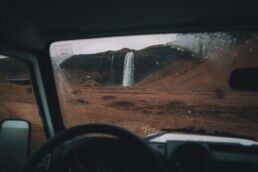
These are some of the easiest directions we’ve got! Only 120km. away, mighty Seljalandsfoss is directly accessible from Route 1 traveling south from Reykjavik, and is a great day trip option. You can reach the falls in just 1 hour and 40-45 minutes from the capital, and you’ll definitely want to make a stop here.
You’ll know you’re close when you see the sign, and it’ll become visible on your right as you approach.
When you arrive at the parking area, you will note that there is a small shop and access to restrooms, but know that these things may not stay open very late at night.
Unlike many dramatic natural treasures of Iceland, this one requires virtually no hiking or meandering into an interior road. Seljalandsfoss and it’s wider cousin Skógafoss are both, in fact, just one turn off of the main road.
PLAN YOUR JOURNEY
Travelling to Iceland?
Check our overnight tours with a driver guide that includes a one night stay in a bubble.*Starting from ISK 74.900 per person
The magical path behind the falls
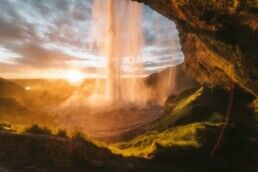
Seljalandsfoss is known for the path that takes you directly behind it. Often photographed from within the cavern behind its thundering curtain, this is a truly magical experience.
The pathway that leads up to the waterfall will lead you behind the falls themselves, and may get you fairly wet depending on the wind and the season. You will be somewhat protected in the shallow cave behind it, but be prepared!
The mist that these great falls create is deceptively heavy, and can create muddy or slippery conditions on the path, or permeate any non waterproof clothes. (Which is likely not how you will want to begin your South Coast tour.)
Like all nature exploration in Iceland, it is good to come armed with the right gear- regardless of how tame the way may appear.
About Seljalandsfoss:
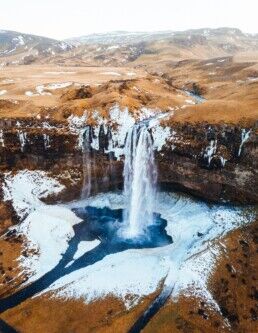
Because of its visible proximity, it would appear that Seljalandsfoss is fed by the meltwater of slumbering Eyjafjallajökull, the glacier nearby. Glaciers in Iceland are the source of many rivers and falls, and while some of the meltwater of Eyjafjallajökull may very well find its way down into the Seljalandsá river, it is not the primary source of the waterfall.
Fed by a spring in the Seljalandsheiði and Hamragarðaheiði heath, the Seljalandsá comes from deep within the shelf of earth that the falls crash down from. We can sometimes guess at the source, by how the water actually looks. A directly glacial source would produce a more opaque type of water- carrying the fine ash, dirt and particulate matter that is so often indicative of glacial runoff.
This is a historically volcanic area- and so of course old ash makes its way into most things, but the waters of Seljalandsfoss are quite clear and free of visible debris.
During the seasonal snow melt, the river can swell and carry more soil and surrounding runoff matter, but typically this source is free of particulate. If you manage to fit in a Golden Circle tour, try comparing the colorful glacial waters of Gullfoss to the cool, clear waters of Seljalandsfoss- and see for yourself! Both are incredibly pure in their own way, but they wear their different sources on their sleeves.
Seljalandsfoss is one of multiple waterfalls in this area. As one of the larger falls, Seljalandsfoss is around 60m high, and it empties into a fairly small pool. Referenced by Ferðafélag Íslands in their 1977 Árbók as an example of a brimrofsfoss or even a brimklifsfoss style fall, these terms describe a waterfall variety that is forced over the top of a cliff edge, as opposed to cataract style falls like Gullfoss.
It is so easy to be visually spellbound by the incredible majesty of Seljalandsfoss, that is can be easy to forget that it is actually part of an entire series of falls that, further upstream, travel through Tröllagil (Troll Gorge) to Tröllagilsmýri (Troll Gorge Marsh) before making the grand finish over the cliff edge. For many of us, the final grand exit of Seljalandsfoss is the only piece of the journey that we will ever witness.
It is however possible to hike the heath above Seljalandsfoss to enjoy the vast view from the top of the land shelf, but it is an experienced hike that is recommended to attempt with a trained guide.
One can look all the way down to the wild sea from atop giant Eyjafjöll, and explore the lush blooming hollows that follow the river all the way down to the falls. Few ever venture this far in- and it is a secret paradise to be sure.
Volume, wind and rainfall change the flow of the water frequently, so you never know what face of Seljalandsfoss you’ll get on any particular visit.
In fact, though the Seljalandsfoss that many of us know today is widely unchanged- large natural events have made their marks on it over time. In January 1976 large precipitation measured at nearby Skógar (101mm.) and a related landslide on Steinholtsjökull glacial tongue released flash flood waters that impacted the visible brink of Seljalandsfoss; and changed the silhouette that locals were so used to, forever.
Lessening its flow spread, the curtain of water that falls down from Seljalandsfoss is now considerably smaller than it was prior to the 1976 flood. As a person who was only born after that flood, it is hard to imagine Seljalandsfoss looking any other way.
Though we find it gorgeous still, it is a good reminder that one can never seek the beauty of nature too often, because you cannot know when it will remake itself.
All of these things are subject to the will of these amazing forces, and we can never know what events will change them. Despite being an island centered around lava and ice, two of the most changeable natural entities that exist- this is a truth that can be hard to absorb.
Seljalandsfoss flows year round, but seasonal factors can create difficulty with accessing it up close. Excessive rainfall can create muddy conditions on the path behind it, and low temperatures in winter can form some outrageous ice.
The path is susceptible to closure if it becomes dangerous, but know that approaching the larger waterfalls in winter can come with some far-reaching frozen paths, due to the range of the mist. It’s never a bad idea to carry hiking poles or crampons if you intend to get close and are concerned about your ice-walking abilities, in the best circumstances. Fortunately, this waterfall is so big that one doesn’t need to get very close to truly appreciate it’s towering grandeur.
A treasure in all seasons- Seljalandsfoss is a wonder under the northern lights, and, the midnight sun. Because of the path behind the water, it is often possible to capture striking rainbow or aurora shots from inside the cavern- a thing you may already have seen on postcards, films, or even your computer screensaver.
In fact, Seljalandsfoss is quite famous for a waterfall! You can see Seljalandsfoss on television in The Amazing Race and Star Trek: Discovery. It also appears in the Justin Bieber music video for the song “I’ll Show You”, and the films CKY2K, and, The Juniper Tree. Not bad for an actor that never talks!
Photographing the falls:
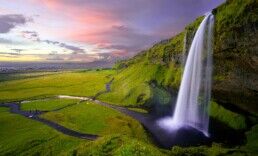
Catching a shot of the sun hitting the water from inside the cavern is surely a bucket list Iceland shot.
If you’re here in the winter, don’t worry! Seljalandsfoss is illuminated through the dark winter nights, and it is a spectacular thing to see- particularly if you can catch an aurora dancing overtop. The soft illumination of the water helps a great deal with an image like this, and really brings out the foreground for an indescribable view.
Like many things in Iceland, (looking at you, auroras-), a wide angle lens can be a great help in situations like these. You will find that despite its fairly tall and thin appearance, once inside the cavern- Seljalandsfoss becomes quite a wide shot.
Cameras take a beating during waterfall shots- and the hardiest rig can get waterlogged if you’re not careful. Be prepared to constantly clear the lens of water droplets otherwise, which can be a big challenge once you are wet yourself.
And don’t forget golden hour! The light in Iceland changes pretty drastically throughout the year, so it is good to be certain. If you are visiting in June, your available light will be very different from a person visiting in March. You can check this, and other similar factors at websites like time & date.
This is a great way to see the light map for the year, the sunrises and sunsets, and even things like moon phase- which is good to know if you plan on shooting northern lights.
You can also use tools like this golden hour calculator– but don’t forget to experiment yourself. Iceland is a photographic treasure box of different types of light, and even with the broodiest cloud cover, you will find that there’s something beautiful to capture. So don’t forget to look for yourself, because that is when some of the most spectacular subjects are to be found.
The nearby secret of Gljúfrabúi waterfall
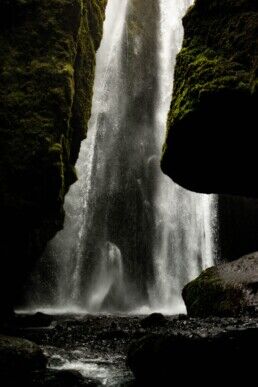
And since you’ve made it all the way down here, we’ll throw in a small tip.
One of our most beautiful waterfalls, Seljalandsfoss is not very secret. (It would be hard to keep that secret at least, seeing as how it is very visible from the main road and massive.)
However, just a bit further to the west- there is a lesser known sibling to this great fall, called Gljúfrabúi, or “Canyon Dweller”. Said to have housed hermits, and possibly the hidden folk themselves- this small waterfall is a rival to its neighbor indeed.
There is a small marked trail between Seljalandsfoss and Gljúfrabúi, and it only takes about 10 minutes to walk. Depending on the water volume that day, you may pass by some smaller falls or rivulets coming down off of the shelf, but you’re looking for something more surprising than that. After nearly 750m., you’ll come to a nondescript slice in the rock shelf. Many pass by this treasure- but it is truly a remarkable thing.
Boasting a smaller 40m. drop, Gljúfrabúi is hidden away by its own palagonite canyon walls, but you can just see it through the eye of the chasm at the entrance. You will see the crystalline stream exiting the canyon, and you can follow it right in. It is possible to wade directly in the stony stream, but if the water volume is low, you can creep along the sides without getting very wet.
Walking down into Gljúfrabúi is like venturing into a layered paper cutting, as the many walls of the tiny canyon jut out and surround you. They are like a myriad of carved doorways in a row, and in the summer they are draped with rich green moss that grows bright off of the delicate mist and dew of the falls.
When you get all the way to the end, you’ll find yourself in an atrium of sorts, where the falls come down. There is a massive boulder there that you can carefully climb for an amazing look up into the light, and of course, for a great photo.
There are many small hiking opportunities around Gljúfrabúi, including ways up onto the heath above for an incredible view. These paths are old and have been enjoyed by locals for generations, but they are challenging and steep, and are best left to experienced hikers.
The view from the heath is spectacular, but it comes with a damp ascent and can be accessed in easier ways with a professional guide. (Besides, they might be able to point out of some of the huldufólk while you’re up there with them! Nothing beats a safe view with a good story.)
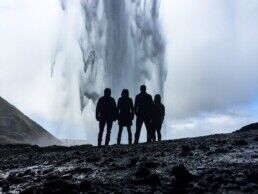
PLAN YOUR JOURNEY
Travelling to Iceland?
Check our overnight tours with a driver guide that includes a one night stay in a bubble.*Starting from ISK 74.900 per person